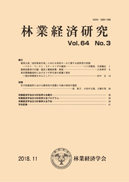All issues

Volume 64 (2018)
- Issue 3 Pages 1-
- Issue 2 Pages 1-
- Issue 1 Pages 4-
Volume 64, Issue 3
Journal of Forest Economics
Displaying 1-6 of 6 articles from this issue
- |<
- <
- 1
- >
- >|
-
2018Volume 64Issue 3 Pages Cover_1
Published: 2018
Released on J-STAGE: March 05, 2019
JOURNAL FREE ACCESSDownload PDF (258K) -
2018Volume 64Issue 3 Pages Toc_1
Published: 2018
Released on J-STAGE: March 05, 2019
JOURNAL FREE ACCESSDownload PDF (258K) -
Application of Best-Worst ScalingSatomi MITSUI, Takahiro KUBOArticle type: Article
2018Volume 64Issue 3 Pages 1-7
Published: 2018
Released on J-STAGE: March 05, 2019
JOURNAL FREE ACCESSProtected areas need to implement appropriate rules to enhance sustainable recreational use. The purpose of this study is to understand the tourists’preference for recreational rules and suggest management policies. The Kinsakubaru native forest in Amami Oshima, which is our study site, is expected to be the World Heritage Site. In part because of media exposure, the number of tourists has been increasing on the island. A questionnaire survey with Best-Worst Scaling was conducted to the tourists who visited Kinsakubaru in August 2017. Our results show that the rule of ‘Mandating the guide tour’was the highest preference for tourists, followed by ‘Introduce the shuttle bus’, ‘Limit the number of tourists’, ‘Raise funds’ and ‘No regulation.’ Furthermore, we found the heterogeneity in preferences from 3 groups classified by the cluster analysis using individual responses. It is necessary to consider the variety of tourists’preferences and prepare the options for the management plan.View full abstractDownload PDF (763K) -
Nobuyuki YAMAMOTOArticle type: Article
2018Volume 64Issue 3 Pages 8-15
Published: 2018
Released on J-STAGE: March 05, 2019
JOURNAL FREE ACCESSOn the basis of migration studies in historical sociology, we examined the influence of repatriation and demobilization of forest engineers on forestry and forest policy in Japan after World War II (WWII) by using historical materials. First, we found that “Gairinkai” influenced forestry and forest policy after WWII. Second, in order to consider this relation, we used quantitative analysis using a list of academic societies and graduate register. Our findings were as follows: 1) more than 20% of the forest society members worked in Gaichi during the war and were divided into two groups, namely, graduates of the Taisho period and young graduates of the Showa period, 2) regarding the assignment location of Gaichi and employment of the Showa period graduates after the war, each school has its own characteristics, and 3) after the war, many Showa graduates worked in forestryrelated educational institutions and administrations.View full abstractDownload PDF (608K) -
Focusing on the Profit-Sharing ForestsWataru TANAKAArticle type: Article
2018Volume 64Issue 3 Pages 16-25
Published: 2018
Released on J-STAGE: March 05, 2019
JOURNAL FREE ACCESSThis study clarified the change and present situation of Japanese boxwood (Buxus microphylla) log production in the profit-sharing forests on Mikura-jima Island, which is a popular area to produce high-quality wood. The profit-sharing forests, which are the main production areas at present, were set on municipal forests located in the Kurosaki-Takao district during the early Showa era. The government of Mikurashima village contracted the profit-sharing forestry for 60 years with villagers who planted and managed the Japanese boxwood trees individually. Subsequently, some of the contracts were extended twice, but most of the contracts were terminated because of management difficulties during grow-out. About 10 log producers worked in the forest and were almost unchanged every year. Most of the log producers cut logs in winter to sell to the Mikurashima village government. Some eager log producers were asked to harvest other contractor’s trees and they sold the logs to the Japanese boxwood customers independently. The profit-sharing forestry has played an certain role in terms of increasing Japanese boxwood resources. On the other, the role of the profit-sharing forestry has been limited in terms of contractor’s income resource because of economic changes.View full abstractDownload PDF (619K) -
Keiko IZUMI, Fumiya ODANAKA, Ikumi OTSUKAArticle type: Short Communication
2018Volume 64Issue 3 Pages 26-35
Published: 2018
Released on J-STAGE: March 05, 2019
JOURNAL FREE ACCESS
- |<
- <
- 1
- >
- >|